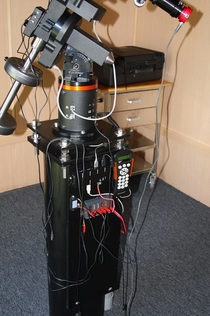Yes, absolutely, at least for me! Here's why...
Last year Celestron came out with a new gadget called StarSense to help speed up the 2 star alignment process and automate it. StarSense is essentially Celestron's answer to Meade's StarLock. I've never liked doing the initial 2 star alignment process and then adding 4 calibration stars. It's a necessary chore, but it's time consuming and can be imprecise. I found myself routinely consuming 30+ minutes of each session with the task. Now there are those who will say that as long as you have a good polar alignment (assuming you have an equatorial mount), tracking shouldn't matter because you can "guide out" minor tracking errors and the alignment is only necessary for "goto" purposes anyway. While that is somewhat true, I find it misleading for a few reasons. First off, a good alignment helps you find and center your imaging targets without having to swap between an eyepiece and the camera, which can save a lot of time and focusing headaches. Secondly, you have to do the alignment regardless in order for the mount to track at all. Lastly, the better the mount is aligned and tracks, the less work that the guider has to do.
With all the in mind, I purchased the StarSense in the Spring, but hadn't really got to test it out well until recently. StarSense uses plate-solving to compare the stars it's pointing to with star maps that it stores in memory. While it's doing this, it models the tracking errors in your mount so it can compute a solution that will take into account both the star alignment and the mount's tracking errors and correct for both . The software was initially riddled with bugs, but they finally got things right early this year. Over repeated use night after night, I've found that StarSense always provides an accurate and consistent alignment, in about 3 minutes of time. That's far faster that I can do it, not to mention much more convenient. Since part of my sky is blocked by trees, I saved a user-align routine that StarSense utilizes for each alignment. It works remarkably well. For instance, I know that I need to tweak my polar alignment after making some adjustments recently. It's off a little - not enough to worry with at the moment or affect imaging - but it's not perfect and I'm somewhat OCD about it. After a StarSense auto-align, my calculated polar error is consistently the same time after time. With the 2 star alignment process, my calculated polar error was always all over the place and rarely consistent, which made me question if it was truly off and by how much without investing the time to do a drift alignment or an all-star polar alignment.
So to wrap this up, here are the pros and cons as I see them:
Pros:
- Fast multi-star alignment routine - typically 3 minutes or less
- You can add up to 10 additional calibration points.
- Consistently accurate alignments
- No need to fight with the finder scope or swap between eyepiece and camera
- The All-Star Polar align routine is FAR easier with StarSense, which is helpful if you don't have a permanently mounted scope
- You get an extra, updated Hand Controller as part of the deal
- Celestron continues to update the firmware and is tweaking and adding features
- Works with almost all of Celestron's scopes, including older ones (nicely played Celestron!)
- The cost is relatively low, considering the cost of most accessories with this hobby.
Cons:
- Initial setup and usage can be somewhat confusing for someone used to the existing NexStar controller. There are a some key differences that add confusion.
- The included manual is not very good. Use the most current PDF version from the website if you get one.
- The 2-Star Alignment process no longer exists with the new hand controller, but there is no reason they could not have included it for the rare times you might want to use it. You can switch hand controllers, but why should you have to?
- It's still not as good as Meade's StarLock. StarLock not only does everything that StarSense does but it can be used as a built-in guider as well. StarLock's computer-assisted polar alignment is also supposedly better. Celestron might be able to eventually add guiding capability by providing some lens/scope retrofits, but I don't know if the camera is sensitive enough for it.
Overall, it's a worthwhile purchase in my opinion. It saves a lot of time, it does what it claims, and it reduces frustration.

 RSS Feed
RSS Feed